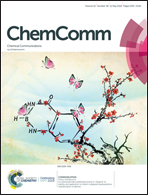Liquid crystalline microspheres of azobenzene amphiphiles formed by thermally induced pH changes in binary water–hydrolytic ionic liquid media†
Abstract
Anionic azobenzene-containing bilayered membranes dispersed in binary water–ionic liquid (IL) media undergo proton-responsive transformation into liquid crystalline microspheres (LCMs). This transformation was induced by protons released by the heat-induced hydrolysis of tetrafluoroborate ions in the ILs. This work demonstrates the first beneficial use of hydrolysis-susceptible ILs in chemistry.



 Please wait while we load your content...
Please wait while we load your content...